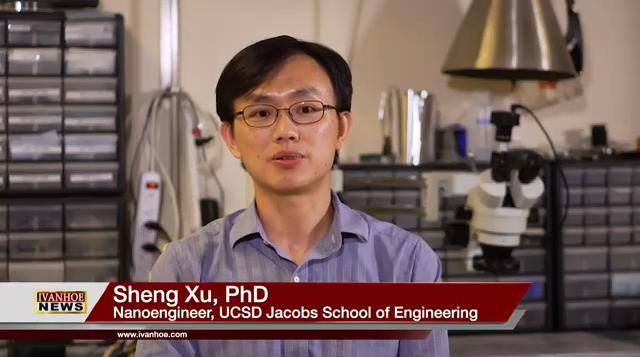UCSD Nanoengineer, Boyu Liu, UCSD Material Sciences student, Sai Thou, and Nanoengineer at the UCSD Jacob School of Engineering, Sheng Xu, PhD, talk about a skin patch that could potentially predict heart attacks and strokes to save people’s lives.
Interview conducted by Ivanhoe Broadcast News in July 2022.
Was this a project for all three of you?
LIU: Actually, it’s led by another student who has already graduated, so, we got involved in this project.
How did you get involved with this?
XU: Well, it’s a long story short. Basically, I was trained at those areas. First of all, I got my PhD degree in Material Science and Engineering at Georgia Tech. And then I moved on to UIUC as a postdoc working on those wearable devices. So then here, when I started my independent career at UCSD and I was thinking about doing some of those unrelated area but different work from my advisors research.
INTERVIEWER: Do you have a couple of different sensors that you’re working on right now?
LIU: Yes.
What does one do, and what does the other do?
LIU: So, what we are doing that can be differentiated from the others is that we are working on soft stretchable sensors, so that those sensors are wearable. So, as you can imagine, if our sensors are wearable, we can put the sensors on. The sensor is just like a patch, so it will not interfere your day activities so that we can do continuous monitoring for the whole day. That’s a major advantage of what we’re doing in comparison with those conventional sensors that can monitor the same signal but in a discrete and discontinuous way.
Could you explain what this is?
THOU: Well, this way is handhold ultrasonic probe. So because we know auto size of every convenient technology help us diagnose all- these all diseases and a lot of companies and engineers want to make it more portable, that’s why we had the handheld portable device now. And this is actually a portable device from Butterfly company.
So, this can do certain things, but it’s pretty limited.
LIU: Yes, because it’s rigid and it will certainly limit some kind of activities you are performing.
Is it ultrasound based?
LIU: Yeah, it’s ultrasound based.
What does that mean?
LIU: Because ultrasound is a mechanical wave that can penetrate the tissue, it gives us the advantage to penetrate tissue and reach the organs deep down. For conventional sensors, they are only able to capture signals of very superficial targets. But with ultrasound, we can penetrate the tissue and get very deep targets like the major arteries and the heart.
Could you presumably wear this center and be told whether you are at risk for a heart attack or stroke?
LIU: Yes. So, by monitoring those hemodynamic parameters, for example, blood pressure and blood flow. So, we are able to predict and detect the onset of those cardiovascular disease and dangerous events.
When you say predict, is it “You are at a high risk for it”, or “You are going to have a stroke in an hour”?
LIU: In terms of prediction, it’s all clinical model-based. What we’re doing here is provide the clinicians this opportunity, that they can continuously monitoring those onsets of the syndromes. For example, so for those patients who have those stroke risks, so they will have certain patterns of their blood flow and blood pressure right before the onset of the stroke so that we can keep monitoring those and we can capture those, onset of those syndromes so that clinicians or the sensor- the back-end machines can receive this alert and so that the stroke events can be predicted.
When you say right before, I know I’m being super specific, but is it right before, as in days, hours, or minutes?
LIU: That also depends on specific kind of stroke, I guess. We are not really the clinicians, so we only have a rough idea of this, but we do know the need of the clinical world, so they need something that can continuously monitor this, because using conventional sensors there are high possibilities that those appearing signals are missed because of discontinuous checking or diagnose, but with our sensors, we can keep looking for those abnormal signals so that we can have a reliable prediction of the syndrome.
Is this what they do in a stress test, but it would be something that you would just wear all day long?
LIU: Yes.
If you are a cardiac patient, would you just always keep this on?
LIU: Yes. There are risks, or even for those healthy people. They can always put the device on because you will not feel anything about it. It’s like just put a patch on your body. It’s similar to those stress tests. This stress test is simulating a extreme situation of your body, but with this kind of sensor, you can just wear it and for all these daily activities. So sometimes you have to exercise really intensively and that’s simulating the stress test and also, there are some valuable signals you can capture during normal activities, for example after you drink water or after a meal. So, all different things can be monitored.
Like what?
LIU: For example, for blood pressure. So it’s a very important vital sign that can indicate the health of the cardiovascular system. But this parameter can vary a lot after a meal, for example, and also this is even related to the posture, for example, if you suddenly stand up, your blood pressure will change. For healthy people it will drop a little bit and then quickly resort for a normal value. So with our sensor because it’s continuously monitoring the entire process so we can capture all these changes and this can be a strong indicators for our clinicians to make diagnosis.
Do you think this is the future of healthcare?
LIU: Yes, we believe so, because sensory development is always going towards a destination, that is, the users cannot feel the sensor and the sensor is always monitoring the thing so that we have the entire picture of the change of your vital signs. We believe this is the future.
Is this just like what you see women who are pregnant? They have an ultrasound.
THOU: Yes. It’s pretty similar to the ultrasonic platform we used in clinical settings, but it’s much smaller as you can see, and it’s handheld, so you can just connect it to your iPhone or any other portable devices to see the actual ultrasonic image of your entire body.
Can you describe the patch?
THOU: For this device, this is the ultrasonic patch we are developing. And as you can see, this one is much smaller. And also one important thing is, it is wearable. Comparing to those previous handhold devices this time we can use this device for long-term monitoring. For example, if we want to monitor our blood pressure for 24 hours ambulatory blood pressure, we can easily attach our patch under the major arteries, for example, I can easily attach it to my carotid artery like this. And we will connect our electrode to the back-end system to do the activation and the signal processing. Right now we can easily just read the blood pressure value from the ultrasonic patch in real time for probably 24 hours while you are sleeping.
What do you want to come out of these wearable devices where you have every patient sent home with one of these that has a heart problem?
XU: Originally, we were thinking about using those wearable ultrasound technologies to monitor the central organs and deep tissues. That’s a new research frontier. And as you can probably agree, those cardiovascular disease is the number one risk factor for the entire population in the world. And we want to particularly use these wearable ultrasound device to monitor the hemodynamics in the central organs. In your heart in your major arteries and veins, so that people can detect those acute diseases before they onset. And that can potentially save lives of millions.
Can you detect that in your body through the sensor?
XU: The point of being wearable is that this device can provide continuous, long-term monitoring of what’s going on in the heart, in your central vessels, in your arteries and veins. So, by monitoring the entire data stream, we can observe the pattern. We can see those underlying causes in those patterns. And then we can use sophisticated algorithms to predict what’s going to happen in the next minute, in the next hour, or in the next few days.
How do you see this rolling out? Do you see this like in every doctor’s office?
XU: Yes. That’s the dream, that’s the goal. Right now, we demonstrated a prototype that it can work on the lab bench. I think my team is going to show you the demo or after this. And as a next step, we are going to spin off a product based on this technology. And as a separate effort, we have a company trying to commercialize this technology.
Would the device be something that you could get through the hospital or pick up from Walgreens, or some place?
XU: Well, that’s a good question. We’re thinking about both ways. We can use this technology on the bedside for those home use. And the patients can monitor those heart conditions and the vascular conditions at home by themselves. We can also put this device in those intensive care environments such as those surgical rooms, for example. And this device right now is wired, it can be readily integrated with existing those medical instruments, which are also wired. So, we can integrate them together so that they will be providing those continuous monitoring, a non-invasive and convenient.
Is it expensive to make?
XU: Right now, everything is made by hand. My team members are all experienced and they can achieve those hatches within several days. And I think if there’s industrial interests that kicks in, then we will be able to manufacture, automate all those processes. And then the manufacturing cost can be done, can be insignificantly cut down. On the material wise. It’s like a very, very low cost I think it’s going to be very affordable.
Even though I thought someone said copper before, is copper expensive still?
XU: Yeah. Copper is a very common commodity you can buy, and right now we buy them at a small quantity. So it’s reasonably priced. And if we scale them up on a large-scale industry manufacturing, then the cost can be very low.
When do you see this actually hitting the market?
XU: I’m always getting asked about this question by those investors. So they always want to make those fast turn around. I think with right conditions, with sufficient investment and a team together, I think we can put this in a market. We can have a minimally viable product ready within two years.
END OF INTERVIEW
This information is intended for additional research purposes only. It is not to be used as a prescription or advice from Ivanhoe Broadcast News, Inc. or any medical professional interviewed. Ivanhoe Broadcast News, Inc. assumes no responsibility for the depth or accuracy of physician statements. Procedures or medicines apply to different people and medical factors; always consult your physician on medical matters.
If you would like more information, please contact:
Liezel Labios
Sign up for a free weekly e-mail on Medical Breakthroughs called First to Know by clicking here




